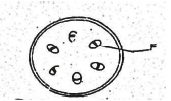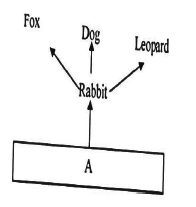231/1
BIOLOGY
PAPER 1 (THEORY)
TIME: 2HOURS.
MARCH 2018
CATHOLIC DIOCESE OF KERICHO (CDK) EXAMS – 2018
PRE-MOCK
BIOLOGY PAPER 1
TIME: 2 HOURS
INSTRUCTIONS TO CANDIDATES
Answer all the questions in the spaces provided.
-
- Name the external feature which is common in birds, fish and reptiles (1mk)
Scales/scale - State two characteristics of fungi (2mks)
- Most have cell wall made up of cultic (or cellulose)
- Most reproduce by means of spores/sporulation
- They are eukaryote/eukaryotic
- They are heterotrophy/ lack chloroplasts/some are saprophytic while others are parasitic
- have network of myphae/mycelia
- store food in form of glycogen or oil droplets (both must be mentioned)
- obtains food/nutrients\
- Shelter
- Name the external feature which is common in birds, fish and reptiles (1mk)
- State the functions of the following parts of a light microscope (2mks)
- Objective lens
Magnification of the object /image - Diaphragm
Regulate amount of light (falling on the object on microscope) acc; adjust/control amount of light
- Objective lens
-
- Define the term seed dormancy
a period of very minimal metabolic activity in an organism - The diagram below represents a stage during germination of a seed

- Define the term seed dormancy
-
- State two causes of chromosomal mutations (2mks)
- Radiations such as alpha, gamma, beta UV and X-rays least one
- chemicals such as colchicine, phenols, bromate, pesticides at least one
- heavy metals eg lead mercury rej symbols
- viruses such as papilloma
- rej; mustard gas-effects gene mutation
- Distinguish between continuous variation and discontinuous variations (2mks)
- State two causes of chromosomal mutations (2mks)
- The diagram below shows a section through a plant organ

-
- Name the class of the plant which the section was obtained (1mk)
Dicotyledonous - Give a reason for your answer in (a) (i) above (1mk)
Vascular bundles arranged in a ring/ presence of vascular
- Name the class of the plant which the section was obtained (1mk)
- State the functions of the part labeled F (1mk)
(divides to) give rise to secondary thickening (growth/ increase in growth/ diameter/ width of stem/ gives rise to new/additional xylem and phloem tissues
-
- State the function of the following cell organelles.
- Ribosome (1mk)
site for protein synthesis - Lysosomes (1mk)
break down worn out cell/organelles/ food materials
- Ribosome (1mk)
-
- Pregnancies continues if the ovary of an expectant mother is removed after 4 months explain (2mks)
the placenta/takes the role of the ovum of producing the hormone progesterone (which maintains pregnancy) - What is the role of the testes in the mammalian reproductive systems (2mks)
Production of gametes/spermatozoa acc male gamete/male sex cells
Production progesterone hormone which maintains pregnancy acc male sex hormones
- Pregnancies continues if the ovary of an expectant mother is removed after 4 months explain (2mks)
- In an experiment the shoot tip of a young tomato plant was decapitated as shown in the diagram below

- State the expected results after 2 weeks (1mk)
auxiliary/lateral buds sprout/branches will be formed - Give a reason for your answer in (a) above (2mks)
decapitation removes the hormone/ouxins/IAA which is produced in the terminal bud/the stem tip; abseul/ remove of the hormone/auxins/IAA promote branch/development of auxiliary lateral buds.
- State the expected results after 2 weeks (1mk)
-
- Distinguish between diffusion and active transport (2mks)
- In diffusion molecules move from a highly conc. Region to a low conc. Region while in active transport molecules move from a lowly concentration region to a highly conc.
- Region on diffusion molecules move along conc. Gradient while in active transport molecules move against conc. Gradient.
- No energy is required in diffusion while energy is required in active transport
- active requires carrier molecules while carrier molecule not required in diffusion
- State one role that is played by osmosis in (2mks)
- Plants
- absorption of water from the soil by root hair cells
- movement of water between plant cells/from cell to cell
- opening one closing of stomata
- support in herbaceous plant due to turgidity
- feeding in insectivorous plant.
- Animals
- Water reabsorption by blood capillaries from renal tubules
- absorption of water in colour dicututary/canal/gut
- movement of water from cell to cell in animals
- Plants
- Distinguish between diffusion and active transport (2mks)
-
- Name the gaseous exchange surface in insects (1mk)
- tracheole
- tracheole
- How is the surface named in (a) above suited to its function (2mks)
- moist for gases to dissolve (in solution) branched
- ramify numerous tubes to increase surface area (for gaseous exchange)
- Name the gaseous exchange surface in insects (1mk)
- Explain why plants do not require specialized excretory organs (2mks)
- Some wastes eg gases easily diffuse out .
- waste products are mainly made from carbohydrate and hence are not harmful as proteineous materials
- waste products are formed slowly
- little accumulation of wasted
- plants are less active
- some waste products (such as O2) and are usable-recycled some waste products are stored in non-toxic forms in leaves, flowers, fruits and old bark.
- Explain how the following factors affect the rate of photosynthesis
- Concentration of carbon (iv) oxide (1mk)
- rate of photosynthesis increases as CO2 concentration increases up to a certain level/optimum level and (vice versa)
- rate of photosynthesis increases as CO2 concentration increases up to a certain level/optimum level and (vice versa)
- Light intensity (1mk)
- Concentration of carbon (iv) oxide (1mk)
- Explain what happens in human when concentration of glucose in the blood decreases below the normal level (4mks)
- Pancreases releases glucagons to stimulate liver cells to convert stored glycogen to glucose;
- fat converted to glucose
- reduces rate of respiration.
- Explain how the carnassial teeth of a dog are adapted to their function (2mks)
- large/powerful for cracking/breaking/crushing bone/slide past each other/
- scissor- like for shearing/cutting/slicing (off) flesh/tendons/skin from bone
-
- State three structural differences between arteries and veins in mammals (2mks)
Artery Veins Thick muscular wall Thin muscular walls No valves (expect at bases of pulmonary artery and aorta) Have valves Narrow lumen Wide lumen - Name a disease that causes thickening and hardening of arteries (1mk)
- State three structural differences between arteries and veins in mammals (2mks)
-
- From the equation given below, calculate the respiratory quotient (RQ)
2C51H98O6+145O2 102CO2 + 98H2O +Energy
Show your working (2mks)
CO2 produced /O2 used = 102 / 145
=0.703 - Identify the substrate respired in the above equation (1mk)
fats
- From the equation given below, calculate the respiratory quotient (RQ)
-
- What is fertilization (1mk)
Fertilization- fusion of male and female nuclei gametes; to form a zygote - Explain how double fertilization takes place in plants (2mks)
One male nuclei fuses with egg to form a (diploid) zygote; while the other male nuclei fuses with (two) polar cells to form (triploid) endosperm nucleus;
- What is fertilization (1mk)
- In an experiment, the pituitary gland of a rat was removed
- State the effect this will have on the quantity of urine produced by the rat (1mk)
More urine will be produced/diuresis - Give a reason for your answer in a above.
Lack of Anti-diuretic hormone/vasopressin therefore less water is reabsorbed
- State the effect this will have on the quantity of urine produced by the rat (1mk)
- The diagram below show part of a food relationship in an ecosystem

- Name the food relationship shown in the diagram (1mk)
food web - Name the trophic level occupied by organism A (1mk)
Primary produce - What is the main source of energy in the ecosystem shown in the diagram above (1mk)
the sun/sunlight
- Name the food relationship shown in the diagram (1mk)
- Other than transport. State two other function of mammalian blood (2mks)
- regulation of PH of the body
- Distribution of heat around the body/regulates temperature
- Below is a nucleic acid stand

- name the nucleic acid (1mk)
RNA - give a reason for your answer in (a) above (1mk)
Has bas uracil
- name the nucleic acid (1mk)
- Name two structures of gaseous exchange in aquatic plants (2mks)
- stomata
- aerenchyma
- What is the significance of chiasma formation during meiotic cell division (1mk)
important genetic exchange takes place resulting in variation -
- Define the term evolution (1mk)
gradual change of living organism from simple life forms to more complex life forms - Give two evidence of organic evolution (2mks)
- Define the term evolution (1mk)
- Identify the stage of cell division below (1mk)

anaphase II - State two characteristics of cells found at the apical meristems (2mks)
- thin wall
- dense cytoplasm
- large vacuole
- The diagram below represents a mature fruit of a certain plant

- State the agent dispersal for the fruit (1mk)
Wind - Give a reason for your answer in (a) above (1mk)
hairy surface - State two other characteristics of fruit and seed dispersal by the agent named in (a) above (2mks)
- State the agent dispersal for the fruit (1mk)
- Explain how the following adaptations will reduce the rate of transpiration (2mks)
- Sunken stomata
- Leaf folding
- Name the disease caused by each of the following microorganism (2mks)
- Plasmodium falciparum
malaria - Entamoeba histolytica
amoebic dysentery
- Plasmodium falciparum
- State two properties of monosaccharaides (2mks)
Download Biology Paper 1 Marking Scheme - CATHOLIC DIOCESE OF KERICHO (CDK) EXAMS – 2018 PRE-MOCK WITH MARKING SCHEME.
Tap Here to Download for 50/-
Get on WhatsApp for 50/-
Why download?
- ✔ To read offline at any time.
- ✔ To Print at your convenience
- ✔ Share Easily with Friends / Students

